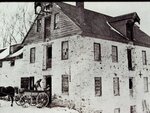

In the heart of Yardley Borough lies a privately owned body of water that dates to the early 1700s. Lake Afton first functioned as a millpond and later as a siltation basin. It has since become the town’s iconic scenic centerpiece.
Lake Afton’s story begins with John Brock, who purchased the land from William Penn in 1682. Starting a business in the early 1700s, Brock and his son Ralph built a gristmill and dug its millpond by hand.
To operate the mill’s waterwheel, they diverted water from Brock Creek, ran it through their millpond, and then directed the flow into the mill. The flour mill served the Brocks well until Ralph sold the property to Thomas Lambert in 1713. Lambert, in turn, sold it to Thomas Yardley in 1726.
Thomas Yardley, the enterprising nephew of emigrant William Yardley, is credited with expanding the existing mill. His descendants followed suit. An addition was erected in 1769. The most significant change came in 1901, when a fire destroyed all but the stone walls of the building. When the mill was reconstructed, a turbine was added, and the primary water source was changed from the millpond to the Delaware Canal. The millpond was no longer a necessity.
The Yardley and Cadwallader families operated the mill until 1942, when all operations ended.
As a result, the millpond had no commercial use until 1948 when Yardley’s largest industry, the Cold Spring Bleachery, purchased the mill and its pond. The Bleachery met some of its vast need for clean water by using the pond as a reservoir and a siltation basin. The pond’s flow was redirected into its plant off North Main Street. The mill building was used for storage.
The millpond’s evolution into Yardley’s scenic centerpiece began in 1877 when the Cadwallader family gave a small piece of land on the south side of the pond for the purpose of constructing a place to house the town’s subscription library.
A fashionable and picturesque Victorian design was selected for the new building, and to suit the elegance of the new library, the millpond was dubbed “Lake Afton.”
It is said that the name was chosen by Marianna “Mazie” Cadwallader, a Yardley descendant. She was inspired by “Afton Waters,” a work by Scottish poet Robert Burns. “Flow gently, sweet Afton, among thy green braes. Flow gently, I’ll sing a song in thy praise.”
Lake Afton became a habitat for plants, algae, and wildlife. This developing ecosystem, along with the smell, captured the community’s attention.
In 1971, in response to growing concerns, three women — Phoebe Griswold, wife of Rev. Frank Griswold, minister of St. Andrew’s Episcopal Church; Linnea Cunningham, who owned a deli in Yardley; and Janet Hays Austin, local artist — formed the core of a group called the Friends of Lake Afton, a nonprofit organization that recognized the lake’s environmental significance.
The Friends’ mission was to preserve and clean up its banks and conduct ecological studies.
The group discovered that the lake was no more than 3-feet-11-inches deep and was not polluted. The objectionable smell was attributed to algae growth.
To this day, the Friends of Lake Afton continue to evaluate and control algae, enhance the water quality, do cleanups, and gather community support for projects to keep the lake in good shape.
When the Cold Spring Bleachery shut its doors in 1975, the land under the lake was bought by five property owners, who continue to generously share Lake Afton with the public for ice skating, fishing, and duck and turtle watching.
Lake Afton is an example of how history, nature, and the community can come together to create something truly magnificent. So, the next time you visit the lake, take a moment to reflect on its rich history and the hard work it takes to preserve it. Please do your part to ensure its future.
Em Bedard is a member of the Yardley Historical Association.
“Heralding Our History” is a weekly feature. Each month, the Herald delves into the history of one of its towns.
Join our readers whose generous donations are making it possible for you to read our news coverage. Help keep local journalism alive and our community strong. Donate today.